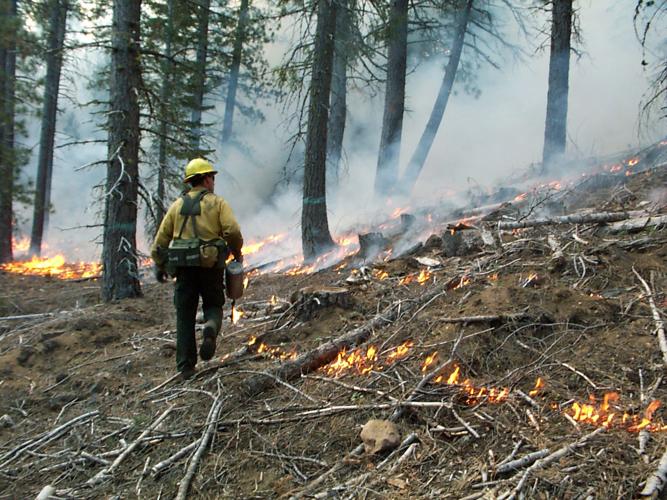That smoke you saw rising from Mount Bigelow in the Santa Catalina Mountains northeast of Tucson Monday should be a more regular sight, say fire historians and forest ecologists.
Two recent studies place different emphasis on the primary causes of fire in the mountains of the West, but the researchers who wrote them agree that restoring forests to a healthy state requires more attention to thinning them out and burning when circumstances permit.
One study, published last month in the Proceedings of the National Academy of Sciences (PNAS), says fuel aridity — the drying of trees by drought and increased temperatures — is the major cause of contemporary fires. The other says human manipulation of the landscape was the key factor in historical fires.
That latter study, published this week in PNAS, found that major sociological changes influenced management of the forests in the Sierra Nevada range in California. That manipulation of the landscape was more important than drought and fuel buildup for more than 400 years when it came to fire susceptibility, the researchers found.
Fire activity was low in the earliest period, from 1600 to 1775, said Valerie Trouet, an associate professor in the University of Arizona Laboratory of Tree-Ring Research and a lead co-author of the study.
The indigenous inhabitants of the Sierra Nevada set fires to drive out animals for hunting and to improve production of food products such as acorns, she said.
“These were small-scale burns, which disrupted the continuity of fuels, such as grasses.”
That changed after 1775, when missionaries and colonists came to California, introducing diseases that drastically reduced the native population and policies against burning. Fire activity doubled.
During a third period, starting in 1866, the fire-scar record in trees showed a decrease in fire. Researchers attributed the reduction to an influx of people after the Gold Rush. Population boomed and forests were logged, while grazing cattle and sheep reduced the load of grasses and other fine fuels.
An even bigger reduction came in the early 1900s, when forest managers introduced a policy of snuffing out fires before they could spread. “You get the Smokey Bear effect,” Trouet said.
She said her research began when she was a post-doctoral researcher with co-author Alan H. Taylor of Penn State’s Earth and Environmental Systems Institute. They set out to find a climatic reason for fires in the Sierra Nevada. But when the researchers combined a 300-year record of fire scars with historical documentation of acres burned since 1908, they found that the changes in land management trumped climate.
That has now changed. By the fourth period, starting in 1987, snuffing out fires became more difficult. That forest fuel buildup, coupled with drought and rising temperatures, made it impossible to contain fires that raged across the landscape.
“Stronger fire–climate relationships have developed since the mid-1980s, and our analysis, and other studies, show that fire activity, particularly at high severity, has increased as a result of warming and earlier spring snowmelt,” the study says.
“Currently climate is the major driver of this recent increase in burned area,” said A. Park Williams, of Columbia University’s Lamont–Doherty Earth Observatory.
Williams was a coauthor of the fuel aridity study published in October that found a changing (hotter, drier) climate responsible for three-quarters of the West’s fires since 1979.
Williams said the record shows that “when there is fuel on the landscape and you dry it out, then fire is inevitable.”
Burning when the fuels are not so dry is a good way to reduce the threat, he said. He said he hopes the evidence being uncovered by scientists will lead to public support for better forest management.
“When there is drought, and as we warm, big fire years will become more common,” he said. “Given that inevitability, we hope the public understands that we can’t continue this policy that we just hope every year that fire doesn’t occur at the wrong time in the wrong place.”
Scott Stephens, an environmental scientist at the University of California, Berkeley, and a co-author of the Sierra Nevada study, said climate may be the driving force in fires right now but over time “the predominant factor is really the social system and ability to change fire regimes quite drastically and abruptly.”
“It gives you hope,” he said. “To me it means there is a possibility of changing trajectories with forest conservation and sustainability efforts. When forests burn frequently, there is a chance to reduce that trajectory,” he said.
The 200 acres burned on Mount Bigelow is a small step, but land managers across the West are planning bigger ones.
The Four Forest Restoration Initiative in Northern Arizona will use thinning and prescribed burning to treat 50,000 acres of ponderosa pine forest in the Kaibab, Coconino, Apache-Sitgreaves and Tonto national forests each year for 20 years.
So far this year, Arizona’s national forests have burned 88,013 acres in prescribed fires.
A wetter than normal spring made it possible for some naturally caused fires to be managed for resource improvement, said Heidi Schewel, spokeswoman for the Coronado National Forest.
The Bigelow burn was a success, Schewel said, and the area will be burned again at five- to seven- year intervals.






